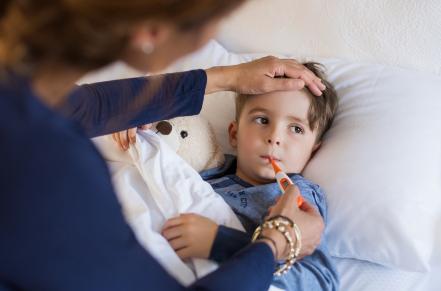What is fifth disease?
Fifth disease is a common illness caused by a virus (Parvovirus B19). The disease often causes a mild, red rash on the face, so it is also called “slapped cheek.” Pregnant women are at risk because the virus that causes fifth disease can harm the developing fetus.
Who gets fifth disease and how?
Children get fifth disease more often than adults. It is most common in winter and spring.
The virus lives in the nose and throat. It spreads from person to person through the air when a person coughs, sneezes, or talks. It can spread when droplets land on surfaces and then are rubbed into the eyes, nose, or mouth. It can also spread by sharing food, eating utensils, and mouthed toys. Women who develop fifth disease during pregnancy can pass the infection to the fetus.
Fifth disease is contagious one to two weeks before the rash appears. A person is no longer contagious once they have a rash.
What are the symptoms of fifth disease?
A child with fifth disease may have:
- Fever
- Headache
- Tiredness
- Muscle pain
- Less common: runny nose, sore throat, itchiness, nausea, vomiting, diarrhea
After four to fourteen days (can be up to 21 days), a child may have:
- A red rash on the face. A child’s cheek may look flushed, looking like someone just slapped it. The rash may look more or less bright red depending on a child’s skin tone.
- A rash on the chest, back, arms, and legs. The rash often looks soft and lace-like.
Children usually feel better once the rash appears. The rash may last for over a week. It may go away and come back, especially with heat, such as with sunlight or a warm bath.
Most people who get fifth disease are not very ill. Not all people with fifth disease have symptoms. However, children with sickle cell anemia, chronic anemia, or an impaired immune system may be very sick when infected with the fifth disease virus and may need medical care.
Is fifth disease dangerous for women who are pregnant?
- If a pregnant woman gets fifth disease for the first time, there is a small risk of miscarriage or stillbirth.
- Women who are pregnant should avoid direct contact with children’s saliva, mucous, and body fluids.
- Staff who are pregnant or expecting to become pregnant should consult with their health care provider about their occupational health risks.
Should a child with fifth disease stay home?
Most children with fifth disease do not need to stay home from child care. People usually realize a child has fifth disease once the rash appears, and the virus is not contagious anymore.
Keep children home if they do not feel well enough to participate or require more care than can be provided without impacting the care of the other children. For example, a child with fifth disease may be fussy and uncomfortable because of fever or itchiness. This can make it difficult for teachers to care for the child while also caring for the rest of the class.
Most children with fifth disease get better on their own. Families should check with their child’s health care provider if they have questions or concerns about their child’s symptoms.
Tips to reduce the risk of fifth disease
Practicing healthy habits can prevent fifth disease:
- Practice good handwashing.
- Wear gloves and wash hands for diaper changes and contact with body fluids.
- Teach children to cough into their elbow and away from people.
- Wipe noses with clean tissues, dispose of them properly, and wash your hands.
- Don not allow children to share food, bottles, toothbrushes, eating utensils, drinking cups, or mouthed toys.
- Follow the routine schedule for cleaning, sanitizing, and disinfecting in Caring for Our Children Appendix K.
- Play outdoors when possible. See recommendations about active outdoor play for more information.
Where can I find more information?
- Centers for Disease Control and Prevention (CDC) https://www.cdc.gov/parvovirus-b19/about/index.html
- American Academy of Pediatrics https://www.healthychildren.org/English/health-issues/conditions/skin/Pages/Fifth-Disease-Parvovirus-B19.aspx
- Shope, T., and Hashikawa, A. (2023) Managing Infectious Diseases in Child Care and Schools,6th Edition, American Academy of Pediatrics (AAP).
Updated March 2024, UCSF California Childcare Health Program







